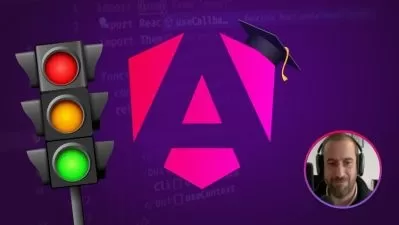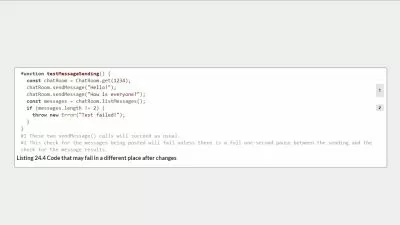Consuming APIs with Angular
Get Arrays
2:06:08
Description
Use Angular to consume API's and build applications using RxJs, Resolvers, and Map API
What You'll Learn?
- Angular
- Angular HTTP Client
- Map API
- Leaflet Map API
- Bootstrap
- Building User Interface
Who is this for?
What You Need to Know?
More details
DescriptionIn this course, you will learn and understand how to create an Angular application that will consume user information from an API.
This course teaches how to use create an API from scratch. This course also dives into defining and creating API, exposing API Endpoints over HTTP, and handling HTTP Requests and File Upload through API Endpoints. It covers testing API Endpoints (using an HTTP client - Postman).
This course is short and focuses only building the Angular application that uses Bootstrap to build the UI components, using the Random User API to fetch the user information, and showing user location on a map using the Leaflet Map API.
In this course, you will learn and understand how to create an Angular application using the Angular CLI. TThe Angular CLI is a command-line interface tool that you use to initialize, develop, scaffold, and maintain Angular applications directly from a command shell.
This course teaches how to use create and work with Angular components. Components are the main building block for Angular applications. Each component consists of:
An HTML template that declares what renders on the page
A TypeScript class that defines behavior
A CSS selector that defines how the component is used in a template
Optionally, CSS styles applied to the template
Most front-end applications need to communicate with a server over the HTTP protocol, to download or upload data and access other back-end services. Angular provides a client HTTP API for Angular applications, the HttpClient service class.
Routing is crucial to any application. In a single-page app, you change what the user sees by showing or hiding portions of the display that correspond to particular components, rather than going out to the server to get a new page. As users perform application tasks, they need to move between the different views that you have defined. This course will show examples how the Angular Router.
Angular Resolver is used for pre-fetching some of the data when the user is navigating from one route to another. It can be defined as a smooth approach for enhancing user experience by loading data before the user navigates to a particular component. An example is built in this course to show a practical use case for Resolvers.
Who this course is for:
- Developers wanting to learn about API
- Developers wanting to learn about Angular
- Developers wanting to learn about Angular HTTP API
In this course, you will learn and understand how to create an Angular application that will consume user information from an API.
This course teaches how to use create an API from scratch. This course also dives into defining and creating API, exposing API Endpoints over HTTP, and handling HTTP Requests and File Upload through API Endpoints. It covers testing API Endpoints (using an HTTP client - Postman).
This course is short and focuses only building the Angular application that uses Bootstrap to build the UI components, using the Random User API to fetch the user information, and showing user location on a map using the Leaflet Map API.
In this course, you will learn and understand how to create an Angular application using the Angular CLI. TThe Angular CLI is a command-line interface tool that you use to initialize, develop, scaffold, and maintain Angular applications directly from a command shell.
This course teaches how to use create and work with Angular components. Components are the main building block for Angular applications. Each component consists of:
An HTML template that declares what renders on the page
A TypeScript class that defines behavior
A CSS selector that defines how the component is used in a template
Optionally, CSS styles applied to the template
Most front-end applications need to communicate with a server over the HTTP protocol, to download or upload data and access other back-end services. Angular provides a client HTTP API for Angular applications, the HttpClient service class.
Routing is crucial to any application. In a single-page app, you change what the user sees by showing or hiding portions of the display that correspond to particular components, rather than going out to the server to get a new page. As users perform application tasks, they need to move between the different views that you have defined. This course will show examples how the Angular Router.
Angular Resolver is used for pre-fetching some of the data when the user is navigating from one route to another. It can be defined as a smooth approach for enhancing user experience by loading data before the user navigates to a particular component. An example is built in this course to show a practical use case for Resolvers.
Who this course is for:
- Developers wanting to learn about API
- Developers wanting to learn about Angular
- Developers wanting to learn about Angular HTTP API
User Reviews
Rating
Get Arrays
Instructor's Courses
Udemy
View courses Udemy- language english
- Training sessions 23
- duration 2:06:08
- English subtitles has
- Release Date 2024/03/22
















